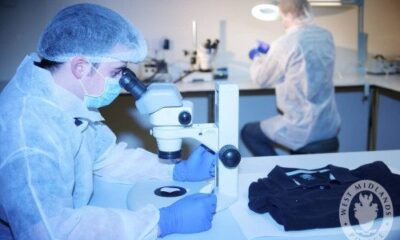Features
Chemistry of the Earth‘s Atmosphere
Richard Wayne and Ann Holloway examine the basic principles of our atmosphere’s chemical make-up and the role and impact of biological processes.
About 99 percent of our atmosphere consists of nitrogen (78 percent) and oxygen (21 percent). The remainder is a mixture of literally hundreds of different chemical species, mostly gases, the most important of which are shown in the table. Particles of aerosols and cloud droplets are also present. Despite their tiny absolute abundances, they not only have obvious meteorological effects, but also provide surfaces and droplets on and in which important chemical reactions can occur.
Richard Wayne and Ann Holloway examine the basic principles of our atmosphere’s chemical make-up and the role and impact of biological processes.
About 99 percent of our atmosphere consists of nitrogen (78 percent) and oxygen (21 percent). The remainder is a mixture of literally hundreds of different chemical species, mostly gases, the most important of which are shown in the table. Particles of aerosols and cloud droplets are also present. Despite their tiny absolute abundances, they not only have obvious meteorological effects, but also provide surfaces and droplets on and in which important chemical reactions can occur.

The gases themselves turn out to be a rather peculiar mixture, because several of them are combustible in the presence of oxygen. Chemists would say the mixture is not at equilibrium. The Sun provides the energy required to drive this disequilibrium, but it’s the living organisms on our planet that bring about the remarkable separation of the chemical species. Our lifeless neighbours Venus and Mars possess atmospheres made up of 95 percent or more carbon dioxide. The early atmospheres of all three planets were probably very similar, but life (and liquid water) on Earth have resulted in almost all of our carbon dioxide being converted into carbonate rocks or transformed into buried fossil carbon. Man is determined to get the carbon out of the ground again and let it react with oxygen, thus leading to the small but inexorable rise in atmospheric carbon dioxide levels that’s behind present-day worries about global warming.
Chemical make-up
Where do the myriad constituents of the atmosphere come from? We probably lost the planet’s original remnant solar atmosphere. Quite early on, however, gases trapped within the planet, in particular nitrogen, carbon dioxide and water, began to escape to form an early atmosphere. Continuing emissions from the planet’s interior, most spectacularly from volcanoes, yield a rich variety of gases and particles. Living organisms generate enormous quantities of gaseous material, a subject we examine later in this article. Mankind is a special case, because we deliberately extract Nature’s products and even manufacture gaseous chemicals not found in Nature at all: chlorofluorocarbons (CFCs) are a well-known example of the latter. Added to these inputs of new material to the atmosphere, chemical changes resulting from reactions between the species already there are continually transforming their identity and concentrations. Some of these reactions convert the gases to new particles that, if they remain suspended in the atmosphere, are aerosols. Balancing the input are sink processes such as deposition to solid surfaces (and possible reaction with them) and dissolution in cloud droplets that are subsequently ‘rained out’.
Atmospheric layers
One exceptionally important minor atmospheric constituent exemplifies the formation of new species by chemical reaction. Ozone (O3) results from the addition of oxygen atoms (O) to oxygen molecules (O2). Ozone itself absorbs solar ultraviolet radiation and warms the atmosphere. Most of the ozone is found in a ‘layer’ at altitudes of about 25km, and so causes warming in that region. Simple physics dictates that temperatures fall with increasing altitude. The colder (and thus relatively denser) air lies on top of the warmer portion, and convection currents are set up that are the source of winds and ‘the weather’. The atmosphere is turbulent – we are in the region called the troposphere (from the Greek for ‘turning’). But when ozone warming is encountered, the temperature trends are reversed (an inversion) and a region of vertical stability is found. The atmosphere can be regarded as ‘layered’ (Greek stratos) and the region is the stratosphere. Roughly 90 percent of the atmospheric ozone is found in the stratosphere, with most of the remaining 10 percent in the troposphere. Figure 1 shows in diagrammatic form where these two atmospheric regions lie.

(Copyright P. Biggs)
Ozone
Quite apart from the dramatic effects it has on the temperature structure and meteorology of the atmosphere, stratospheric ozone has another very important role to play. Because it absorbs ultraviolet radiation it is a key part of the atmospheric system that shields living organisms on the surface of the planet from lethal wavelengths in the Sun’s rays. For this reason, there has been great concern about the damaging effects of CFCs on the ozone layer, as demonstrated most strikingly in the polar (especially Antarctic) ‘ozone holes’ that were discovered in about 1978. Ozone in the troposphere is also vital, but for a different reason. It is responsible, by one mechanism or another, for the initiation of much of the oxidation that leads to the removal of other trace gases entering the atmosphere that could otherwise build up and have noxious or toxic effects. This ‘cleansing’ of the atmosphere is, indeed, an important aspect of atmospheric chemistry.
The biological contribution
The biological generation of atmospheric constituents is shown most clearly in the case of oxygen, one of the ‘major’ gases. Photosynthesis by plants is responsible for virtually all the oxygen in our atmosphere. Carbon dioxide (CO2) and water (H2O) are converted by plants’ chlorophyll-based system into oxygen and carbohydrate. Before the evolution of plants, micro-organisms such as cyanobacteria were responsible for the gradual build-up of oxygen.
The natural cycle
At present, all the oxygen in the atmosphere passes through a cycle of consumption and regeneration in a period of about 3,000 years, astonishingly short on geological timescales. We can now illustrate the closure of the oxidation cycle by invoking another microbiological process. One source (out of many) of atmospheric methane is the fermentation of carbohydrate (grass) in the stomachs of ruminant animals such as cows, as illustrated in Figure 2. Despite cows’ protestations to the contrary, they release significant quantities of methane to the atmosphere from each extremity of their anatomy. It’s said to be dangerous to strike a match near either end of a cow! Once in the atmosphere, the methane is oxidised in stages, with the end products being CO2 and H2O. The H2O becomes rain, and it and the CO2 are converted by photosynthesis in the grass to carbohydrate. The cow eats the grass, the carbohydrate ferments, and so the cycle begins again.
 (Copyright R.P. Wayne)
(Copyright R.P. Wayne)
Oxygen
What purposes do the atmospheric constituents serve? Oxygen might be regarded by organisms that respire, including us, as essential to life. However, there are plenty of anaerobic microbes that do as well, or better, without oxygen. On the other hand, oxygen is certainly an essential component of the oxidising chemical system that ultimately degrades many other chemical species released to the atmosphere. Perhaps most importantly, it’s the precursor of ozone. Oxygen and ozone, between them, remove from the Sun’s rays the shorter wavelength radiation that would make life impossible on the planet’s surface.
Carbon dioxide
Carbon dioxide is the ‘feedstock’ for photosynthesis; without it neither carbohydrates (and thus fossil fuels) nor oxygen could be formed. Carbon dioxide and water vapour are greenhouse gases – they ‘trap’ solar infrared radiation and act as a blanket to keep our planet warmer than it would be otherwise. With too little carbon dioxide, Earth would be much colder than it is, water would be frozen, and life would not evolve. Of course, the corollary is that too much carbon dioxide might lead to too much warming, a truly serious concern in the 21st century.
Nitrogen
The nitrogen in the atmosphere should not be regarded merely as ‘filler’. For example, it is used by bacteria in the root nodules of leguminous plants to produce nitrate ions that are plant nutrients. Some nitrogen is converted by lightning to nitrate in the atmosphere that is rained out, again fertilising the ground.
The right balance
The quantitative composition of the atmosphere seems curiously ‘right’ for us. Just a little more oxygen and all vegetation would burn up. Just a little less or more carbon dioxide and it would be too cold or hot (for us, at least), and so on. Many of the trace gases found in the atmosphere influence aspects of the relatively hospitable environment in which we and all living creatures exist. Greenhouse gases control temperatures, and have conspired to keep some water liquid ever since life first emerged. Different trace gases (methane, oxides of nitrogen, halogens) can modulate the concentration of stratospheric ozone and thus modify the spectrum of solar radiation reaching us. Yet others such as dimethylsulfide are believed to be able to influence cloudiness, and thus the total intensity of light reaching the surface. The chemical species involved act in some way like ‘messengers’. What’s more: most are produced by the biota, and at the same time affect the living conditions of organisms. These are examples of biogeochemical feedbacks. The Gaia Hypothesis proposed by James Lovelock sees these feedbacks and interactions as so intense that the entire system of atmosphere–geology–biology is to be regarded as a single entity. Trace gases become analogous to the blood in a body: not in itself alive, but essential to the life system and for conveying information chemically around it.
Richard P. Wayne is Emeritus Professor of Chemistry at the University of Oxford. Ann M. Holloway is an Oxford chemist by background and she is now a teacher of mathematics at a secondary school. They co-authored the book Atmospheric Chemistry published by the Royal Society of Chemistry (Cambridge, 2010). ISBN 978-1-84755-807-7 Pbk. Further details can be found at www.rsc.org. The publisher has permitted us to reproduce illustrations from the book.


 Environment10 months ago
Environment10 months agoAre Polymer Banknotes: an Eco-Friendly Trend or a Groundswell?

 Environment12 months ago
Environment12 months agoEco-Friendly Home Improvements: Top 7 Upgrades for 2025

 Features9 months ago
Features9 months agoEco-Friendly Cryptocurrencies: Sustainable Investment Choices

 Features10 months ago
Features10 months agoEco-Friendly Crypto Traders Must Find the Right Exchange





























